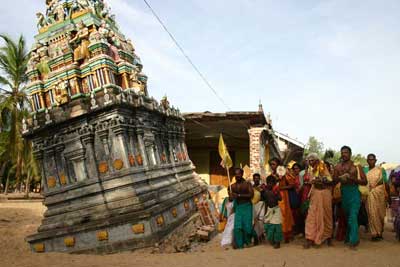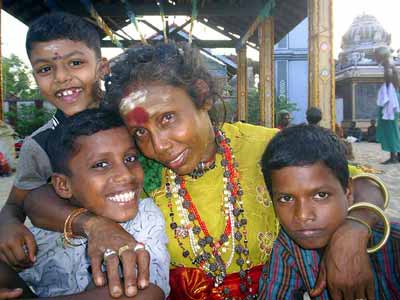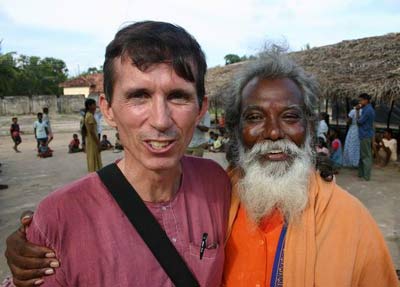
|
|||||||||||||
|
| |||||||||||||
 Pada Yatra follows Tsunami's trail of destruction
Despite a devastating tsunami that destroyed whole villages along the length of its east coastal route, the annual tradition of Kataragama Pada Yatra continues to attract hundreds of hardy foot pilgrims. Under the banner of the Living Heritage Trust, traditional pilgrimage activities and tsunami relief work go hand in hand. (COLOMBO) Living Heritage Trust spokesman Manik Sandrasagra today released details on of the Trust's role in tsunami recovery operations in association with the annual pada yatra or foot pilgrimage from Jaffna to Kataragama. The entire east coastal route of the two-month pilgrimage was hit by the tsunami, with some temples and even whole villages being completely destroyed. Since 1988 the Living Heritage affiliated Kataragama Devotees Trust has annually coordinated the yatra on its odyssey by notifying devotees and temples all up and down the East Coast. It also facilitates dana, the ritual sharing of food and hospitality, which remains essential to the pilgrimage, since most pilgrims are poor and none can carry food for weeks. Now it has taken on the new role of disaster recovery. Although hundreds of Pada Yatra pilgrims live in close proximity to the shore, there was not a single reported instance of one losing his or her life to the tsunami, a fact that devotees attribute to the Kataragama God's unseen hand. However, many Pada Yatra devotees lost their homes and loved ones to the fury of the tsunami's waves. Some lost parents; others lost some or even all of their children. Because of its close association with villages of the east coast, Living Heritage was quick to respond to the catastrophe. Within days of the disaster, volunteers were delivering urgently needed cash, clothing, dry rations, and encouragement to some of the most remote east coastal villages, often even before the major relief agencies. Maximum impactLiving Heritage volunteers did not stop after the first awful weeks. Even more volunteers, both Sinhala and Tamil, as well as foreign volunteers from the UK and North America, began applying for service via the Living Heritage network of web sites. The Trust's efforts focused upon Batticaloa and Ampara districts, where the tsunami created the greatest number of refugees. Living Heritage Trust volunteers have built temporary and permanent homes for families in Kallady, Pasikudah, Mutur, and Akkaraippattu vicinities. They have been helping to build fishing boats with nets and tools to restore the livelihoods of fishermen, masons, carpenters, and other skilled workers in Kallady, Karaitivu, Palamunai, and other villages. "We are not a capital-intensive NGO, like the big international relief agencies that have come to Sri Lanka", explains Living Heritage Disaster Relief Coordinator Patrick Harrigan. "Without big funds or deep pockets of international NGOs, we have had to generate our own funding from friends and sympathizers in Sri Lanka and abroad." "Our strength lies in our long association over decades with the villagers of these coastal communities where the Pada Yatra passes through. So to be effective, we have to leverage our human resources—especially local knowledge and volunteer labour—to maximize the impact at ground level." Living Heritage volunteers from Sri Lanka, UK, Canada, and America come with backgrounds in such fields as building construction, office administration, and social work. Foreign volunteers serve for as little as one month or as long as one year, bringing their own financial resources with which to undertake small projects. Most Sri Lankan volunteers are Kataragama devotees who have also walked in the Pada Yatra. OrphansMost foreign volunteers, however, offer to work on the Anathi Project, which assists dozens of children's homes throughout Batticaloa and Ampara districts. The homes, established mainly due to the ethnic conflict, have had to absorb newly orphaned children since the tsunami. Even before the tsunami, living conditions in the homes were far from ideal, with many children suffering from malnutrition. Foreign volunteers spend much of their time making friends with the children, and lavishing much needed attention upon them. Some teach English, sports, or basic computer skills. All try to address the health, nutrition and sanitation needs of the homes. Those with requisite skills go from one home to another, building, repairing and maintaining facilities. Tsunami artLiving Heritage Trust volunteers distributed paper, water colours, and crayons to the teachers of schools in tsunami effected regions, and asked them to have the children to draw their memories of the tsunami. The result is a series pictures ranging from the very simple to the complex, but all are highly emotive and powerful in their depictions of the power of the wave, in contrast to mankind's, and the children's own, vulnerability. This simple, therapeutic exercise, designed to let children to purge themselves of traumatic memories of tsunami, has been resonating across the art world in Europe and America. The BBC recently reported that London's Tate Britain and the National Museums and Galleries of Wales are interested in showing the collection of children's drawings. Other children's paintings were sent to the United States and are currently on exhibit at the Picasso Mio gallery in Madrid (www.picassomio.com) until 27 July. Money raised will be divided between the child artists, their schools, needy children's homes, and the Living Heritage Trust, which is also planning to exhibit the art in Colombo as well. RevivalThe age-old tradition of Pada Yatra fell into abeyance with the 1983 civil disturbances but was revived in 1988 under Kataragama Devotees Trust patronage. The number of pilgrims has grown steadily ever since. Last year Wildlife Department officials counted over 30,000 pilgrims walking the last 100-kilometre stretch through the Yala East National Park. "We have been privileged to keep the lamp burning through all these long dark years," says Sandrasagra, adding "Now we are holding it up for all to see." For more information about Living Heritage visit www.LivingHeritage.org Enquiries by e-mail: info@padayatra.org 2005 Pada Yatra Photo Gallery I 2005 Pada Yatra Photo Gallery II www.Kataragama.org
|


